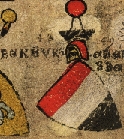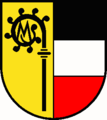Bechburg (noble family)

The barons of Bechburg were a noble family in the Swiss plateau, who had their original seat at the Fahr von Wolfwil in the 11th century . On the right side of the Aare they owned the Rotenberg Castle ( Rotinberc ) near Roggwil BE , a fiefdom of the Counts of Frohburg . Along the trade route from the Alps over the Aare and the Upper Hauenstein through the Waldenburg Valley to Basel , they expanded the control options in the middle of the 11th century with the Alt-Bechburg castle in the municipality of Holderbank SO, which is now in ruins . The last male representative of the family, Henmann von Bechburg, died in 1386 in the battle of Sempach , with which the family died out. The property fell to the feudal lords of the Bechburgs and various nobles.
history
origin
The von Bechburg family apparently had their origins in the area of the Aare crossing near Wolfwil and on a Rotenberg castle ( Rotinberc ) near Roggwil BE. This early castle complex had been abandoned before 1200, as evidenced by an exchange of goods with the young St. Urban Monastery : Ulrich and his two nephews Rudolf and Conrad von Bechburg gave the abbey extensive ownership - perhaps a dozen buggies - in the village of Roggwil and received twelve Schupposen in Oberbuchsiten and an estate in Altbüron . On this occasion, the three Bechburgers renounced the "Platz der Burg Rotenberg" to their liege lord, Count Hermann II von Frohburg, so that he could in turn transfer the location to the monastery. The goods exchanged comprised an estimated half of the village of Roggwil. The other half of Roggwil, 19 Schupposen, had already been bequeathed to the abbey by the three brothers Kuno, Konrad and Arnold, knights of Roggwil, when the St. Urban monastery was founded in 1194. The first two entered the monastery on this occasion. It is believed that Rotenberg could have been their seat and that they were either relatives or vassals of the barons of Bechburg.
With this exchange of goods - the Bechburgers implicitly transferred Twing and Bann as well as the lower court of Roggwil to the St. Urban monastery - a shift in the interests of the barons of Bechburg from the regular estates south of the Aare to their new headquarters, the Alt- Bechburg near Holderbank SO, visible. Wolfwil remained the southernmost part of the property with ferry rights across the Aare.
The Alt-Bechburg was built in the 11th century by the barons of Bechburg. In the course of time, the two parts of the castle passed to different descendants, making the complex a double castle, a Ganerbeburg . The family only retained the rear castle as their own castle, the front one belonged as a fief to the Bishop of Basel , who enfeoffed the Counts of Frohburg , which they in turn conferred as an after-fief to the Counts of Falkenstein , who came from a side branch of the Bechburgs. In 1325 and 1336 the knight Heinrich von Ifenthal bought both halves.
coat of arms

Blazon : divided twice by red, silver and black.
The coat of arms of the "BEKBVRG" is documented in the Zurich coat of arms around 1335/1345. The related counts and barons of Falkenstein use the same coat of arms as the barons of Bechburg.
The municipality of Holderbank SO has a coat of arms that goes back to the Barons von Bechburg. In contrast to the Bechburg coat of arms, the division is oblique, and there is also a red Gothic h in the silver field. In the municipality of Eppenberg-Wöschnau , the unchanged coat of arms of Bechburg is covered with a blue, right-turned sickle with a golden handle, in Schönenwerd with a lily divided into silver, red and silver. In the left half of the shield in the coat of arms of the municipality of Mümliswil-Ramiswil , the colors of Bechburg can be found in the reverse order of black-silver-red. The coat of arms was adopted unchanged for the Solothurn district of Gäu .
Well-known representatives
Henmann von Bechburg
Henmann von Bechburg (* unknown, † July 9, 1386 in the Battle of Sempach ) was the last male representative of the baron family. As with other landed aristocrats in the second half of the 14th century, the sources report that it was money worries: In 1371 he had to pledge the interest income from Niederbipp to the Solothurn mint master Cuntzmann Tragbott.
During this time he did military service for Jean III. de Vienne, the Bishop of Basel , who withheld compensation from him. Henmann, for example, attacked a transport of Basel merchants in the hamlet of St. Wolfgang near Balsthal in 1374 and captured, among other things, a considerable amount of precious saffron. This breach of the peace led to a 14-day siege of his castle Neu-Falkenstein by Landgrave Rudolf IV of Neuenburg-Nidau and his two brothers-in-law, Count Hartmann III. von Kyburg and Sigmund II. von Thierstein , by troops from Bern and 100 riflemen with a throwing machine from Basel. Despite stubborn defense, his Neu-Falkenstein castle was captured and partially destroyed. The nobles paid a large amount of compensation, and the sixteen mercenaries who had defended the castle were beheaded in the courtyard. The merchants did not get all of their saffron back: part of it was distributed among the victors to cover the costs of the war. The incident went down in history as the Saffron War. After his peace agreement with Basel, he was compensated for his earlier claims with 5,800 guilders and was able to have the damage to the castle repaired.
In 1380 he had to pledge Neu-Falkenstein Castle to Rutschmann von Blauenstein, to whom Duke Leopold III in the army after Henmann's death . from Austria on July 9, 1386 in the battle of Sempach the plant and the associated rights of domination fell, for example also Dorf and Fahr Wolfwil.
literature
- Ferdinand Eggenschwiler: On the history of the barons of Bechburg, part 2 (= communications from the Historical Association of the Canton of Solothurn . Issue 3). C. Gassmann, Solothurn 1907, OCLC 645662697 .
- Ambros Kocher: Solothurn document book . First volume: 762–1245 . State Chancellery of the Canton of Solothurn, Solothurn 1952.
- Hans Sigrist: The barons of Bechburg and the Oberaargau . In: Yearbook of the Oberaargau . tape 3 . Schelbli + Co., Herzogenbuchsee 1960, p. 105–111 ( unibe.ch [PDF; 44 kB ]).
Individual evidence
- ↑ Two castle sites have been documented in the Wolfwil area: “Immediately above the Aare crossing at Fahr, remains of a former castle site are documented; furthermore we find in the middle of the forest between Wolfwil and Niederbuchsiten , directly above the mentioned path from Buchsiterberge after driving from Wolfwil , the field names «Schlosshubel», […] “. Sigrist: 110.
- ^ Sigrist 1960: pp. 106-107.
- ↑ Zurich coat of arms roll. Parchment strips II, front side 8 (number 95).
- ↑ Scheibler's book of arms . P. 71.
- ↑ Sigrist: p. 108.
Web links
- Werner Meyer : Bechburg, from. In: Historical Lexicon of Switzerland .
- Hans Sigrist: Bechburg. In: Historical Lexicon of Switzerland .




